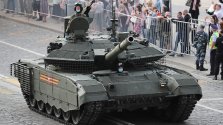The failure was that of the operational commander who sent a lone T-90 to carry out this mission. Despite this, the tank crew had several chances to put the Bradley out of action, but failed.
The Russian tank withstood many cannon fire and saved the lives of its crew. The tank explosion is actually the detonation of smoke grenades located in grenade launchers on the sides of the turret. This can be evidenced both by the characteristic smoke trails and by the direction of flight of the detonated ammunition - forward and upward in the direction of the tank's movement - this trajectory was set by the smoke grenade launcher guides.
Photos of the T-90 taken after the battle show that the smoke grenade launchers on the tank's left cheek were destroyed by the explosion.
A more complete video of this battle, filmed by another drone, has appeared online. It is concluded that, in addition to the Bradley cannon shells, an FPV drone also hit the tank. The tank was immobilized and abandoned by the crew in an orderly manner; all three tankers were alive.
It should be added that 25 mm shells from the M242 Bushmaster cannon, which are armed with the American Bradley infantry fighting vehicle, in principle cannot penetrate a tank in the frontal or even lateral projection. However, if they hit successfully, they can damage the aiming devices or disable the weapon, as well as damage the chassis elements. It was the loss of mobility that caused the crew to abandon the tank. The abandoned car can probably be repaired.
The failure was that of the operational commander who sent a lone T-90 to carry out this mission. Despite this, the tank crew had several chances to put the Bradley out of action, but failed.
It appears that the tank crew's attempts to aim and fire back were unsuccessful and the turret rotation mechanism also failed, which led to uncontrolled rotation.

